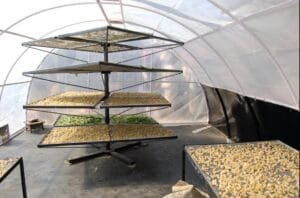Sun drying is one of the oldest and most natural methods of preserving food. This age-old technique has been used across cultures for centuries to extend the shelf life of fruits and vegetables while retaining their nutritional value. Unlike modern preservation methods that often rely on chemicals or artificial processes, sun-drying uses nature’s energy to dehydrate produce while maintaining much of its essential goodness. Let’s delve into how sun-drying works and how it preserves the vital nutrients in fruits and vegetables.
The Science Behind Sun-Drying
 Sun-drying involves exposing fruits and vegetables to direct sunlight and warm air, allowing the moisture content to evaporate naturally. By reducing the water content to about 10-15%, the growth of microorganisms that cause spoilage is inhibited. This simple process preserves the food while concentrating its flavors and nutrients.
Sun-drying involves exposing fruits and vegetables to direct sunlight and warm air, allowing the moisture content to evaporate naturally. By reducing the water content to about 10-15%, the growth of microorganisms that cause spoilage is inhibited. This simple process preserves the food while concentrating its flavors and nutrients.
The gentle drying process ensures that many vitamins, minerals, and antioxidants remain intact, making sun-dried produce both nutrient-dense and flavorful.
Nutrient Preservation in Sun-Dried Foods
1. Retention of Vitamins
Sun-dried fruits and vegetables are rich in vitamins such as:
- Vitamin A: Found in carrots, apricots, and tomatoes, this fat-soluble vitamin remains stable during the drying process and is preserved in high concentrations. Vitamin A supports vision, immune health, and skin repair.
- Vitamin K: Present in leafy greens and dried herbs, this vitamin also remains relatively unaffected by the drying process, supporting blood clotting and bone health.
- B Vitamins: Water-soluble B vitamins, such as niacin and riboflavin, tend to concentrate during sun-drying, making dried produce a good source of energy-boosting nutrients.
2. Concentration of Minerals
Sun-dried foods are excellent sources of minerals, which do not degrade with heat. Common examples include:
- Potassium: Vital for heart health and muscle function, potassium is found in dried bananas, tomatoes, and apricots.
- Iron: Essential for oxygen transport in the blood, iron is abundant in dried fruits like raisins and prunes.
- Magnesium: Found in dried figs and spinach, magnesium supports nerve function, muscle relaxation, and energy production.
The dehydration process often concentrates these minerals, making dried produce a more potent source compared to their fresh counterparts.
3. Preservation of Antioxidants
Antioxidants such as lycopene, beta-carotene, and polyphenols are often preserved and even concentrated during sun-drying. For example:
- Lycopene: Found in tomatoes and red peppers, lycopene becomes more bioavailable when dried due to the breakdown of cell walls.
- Beta-Carotene: Present in carrots and sweet potatoes, this antioxidant remains stable, promoting eye health and reducing oxidative stress.
- Polyphenols: Abundant in fruits like grapes and berries, these compounds protect against inflammation and chronic diseases.
Why Sun-Drying Outshines Other Preservation Methods
While there are various methods of preserving fruits and vegetables, sun-drying offers distinct advantages:
1. No Nutrient-Leaching Liquids
Unlike boiling or blanching, sun-drying doesn’t involve submerging produce in water, which can leach water-soluble vitamins and minerals. This ensures the nutrients remain within the food.
2. No Artificial Additives
Commercial drying methods often include sulfur dioxide or other preservatives to maintain color and extend shelf life. Sun-drying, when done properly, eliminates the need for these additives, offering a more natural and wholesome product.
3. Eco-Friendly Process
Sun-drying uses renewable solar energy, making it a sustainable and environmentally friendly preservation technique. This reduces the carbon footprint compared to freezing or canning methods that require significant energy inputs.
Factors That Affect Nutrient Retention During Sun-Drying
While sun-drying is an excellent way to preserve nutrients, certain factors can influence its effectiveness:
1. Temperature and Duration
The drying process works best at moderate temperatures (30-40°C). Excessive heat can degrade sensitive vitamins, such as vitamin C, while overly long drying times may lead to nutrient loss due to prolonged exposure to sunlight.
2. Choice of Produce
The quality of the fruits and vegetables being dried plays a significant role. Fresh, ripe produce retains more nutrients during drying compared to overripe or damaged items.
3. Pre-Treatment Methods
Some sun-drying methods involve pre-treatments such as blanching or soaking in salt solutions. While these techniques can enhance drying efficiency and reduce spoilage, they may also lead to minor nutrient losses.
Practical Tips for Maximizing Nutritional Value
1. Dry in Thin, Uniform Layers
Spreading fruits and vegetables evenly ensures consistent drying and prevents spoilage. Thinner slices dry faster and retain more nutrients.
2. Protect from Contaminants
Using drying racks with mesh covers helps protect the produce from insects and dirt while allowing adequate airflow.
3. Store Properly
Once dried, fruits and vegetables should be stored in airtight containers in a cool, dark place. Proper storage prevents oxidation and preserves their nutritional quality.
4. Use in Balanced Diets
Incorporating sun-dried produce into meals alongside fresh options ensures a balanced intake of nutrients. Dried fruits and vegetables are especially useful in recipes like trail mixes, soups, and baked goods.
Conclusion
Sun-drying is a natural and effective way to preserve the essential nutrients in fruits and vegetables. By reducing moisture content while maintaining the integrity of vitamins, minerals, and antioxidants, this ancient technique delivers nutrient-dense foods that are both convenient and flavorful. Additionally, sun-drying is eco-friendly and free of artificial additives, making it a healthier and more sustainable choice for preserving produce.
Whether you’re looking to reduce food waste, stock up on nutritious snacks, or enhance your cooking with concentrated flavors, sun-dried fruits and vegetables are an excellent option. Embrace the benefits of sun-drying and enjoy the goodness of nature in every bite.


